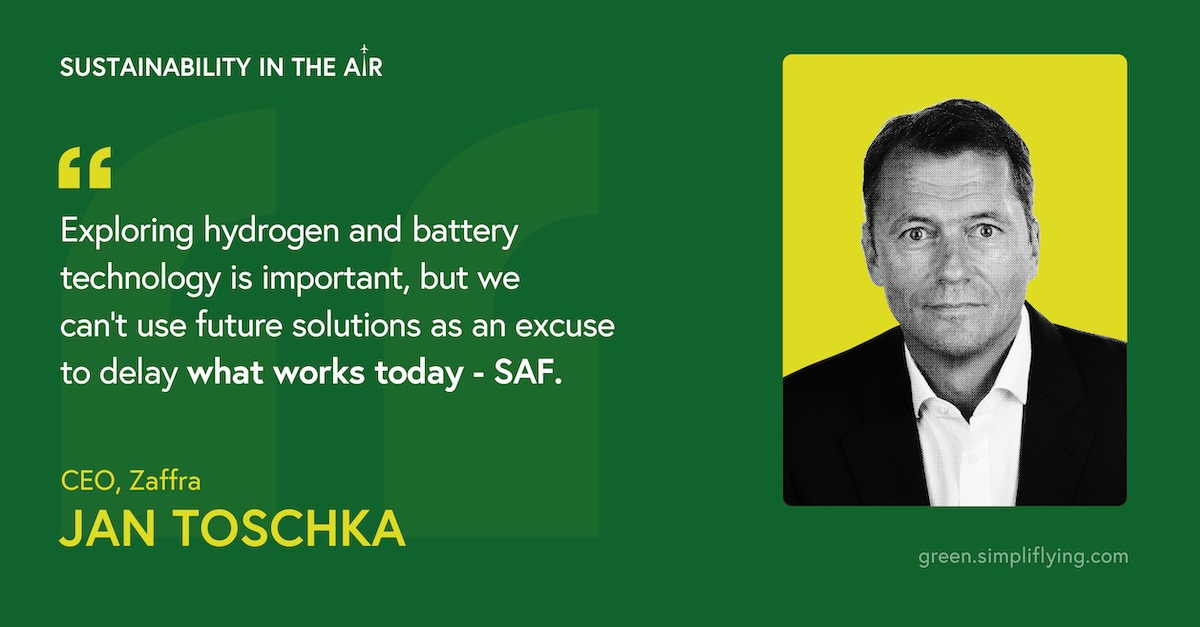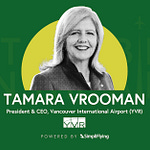In this episode of our ‘Sustainability in the Air’ podcast, Jan Toschka, CEO of Zaffra, speaks with SimpliFlying’s CEO Shashank Nigam, and shares his vision for scaling sustainable aviation fuel (SAF) production and why he believes the industry should act now rather than wait for “perfect” solutions.
Zaffra, a newly formed joint venture between global chemicals and energy company Sasol and carbon emission reduction technology leader Topsoe, is positioning itself to become a key player in SAF production. Headquartered in Amsterdam, the 50-50 partnership seeks to combine Sasol’s extensive experience in asset development and plant operations with Topsoe’s expertise in carbon emission reduction technologies.
Here are the key highlights of the conversation:
Understanding Zaffra’s unique positioning (2:23)
Making SAF investments manageable (15:25)
SAF mandates vs incentives (24:04)
Book and claim’s role in SAF distribution (26:35)
The future of SAF beyond 2030 (31:58)
Rapid fire! (35:01)
Keep reading for a detailed overview of the episode.
Why scaling SAF production matters for aviation
The aviation industry’s path to decarbonisation encompasses multiple potential solutions, including hydrogen and electric aircraft. However, SAF stands out as a critical pathway, especially for addressing emissions from long-haul flights in the immediate future, says Toschka.
With nearly 30,000 commercial aircraft in service at the moment, each with a potential 30-year lifespan, the aviation industry faces significant inertia in transitioning to alternative propulsion systems, underscoring the need for immediate action on SAF production. The industry cannot afford to wait for perfect solutions like hydrogen or electric aircraft, says Toschka.
“Not just replacing the fleet, but also making the infrastructural investments at airports for charging or hydrogen supply chains... that will take years, probably decades. It is dangerous to focus on and wait for ‘perfect’ solutions.”
Whilst some industry voices have questioned whether focusing on SAF might divert resources from other promising technologies like hydrogen, Toschka advocates for a pragmatic approach that acknowledges both the immediate necessity of SAF and the potential for other solutions to emerge over time: “We don’t know with absolute certainty if hydrogen or battery-powered planes will be viable for long-haul flights in the next 30 or 50 years, but we cannot afford to lose time. We need to make progress with SAF to reduce emissions in the meantime.”
4 takeaways from the conversation
1. Combining technology expertise for competitive advantage
Zaffra’s approach to SAF production encompasses two distinct technology pathways:
The first category, renewable SAF, utilises renewable feedstocks, including virgin oils, used oils, fats and biomass. Within this category, HEFA technology currently represents the most commercially viable and de-risked production pathway, with Topsoe’s HydroFlex™ technology holding a significant market share in hydrocracking processes.
The second category focuses on synthetic fuels made from water, renewable electricity, and CO2. “Going forward, as SAF and synthetic fuels scale up, the Fischer-Tropsch-based power-to-liquid (PtL) pathway is expected to have a competitive edge, offering the highest production yields with the lowest electricity and hydrogen use, thanks to the combined technology of Sasol and Topsoe,” notes Toschka.
This dual-technology approach positions Zaffra uniquely in the SAF market. The company can leverage Topsoe’s expertise in HEFA technology for immediate production whilst developing its synthetic fuel capabilities through the combined technology strengths of both parent companies.
2. Breaking down the SAF investment challenge
The European aviation industry faces a significant financing challenge: an estimated €250 billion investment needed by 2050 to construct 150 SAF refineries. However, when examined through the lens of annual figures and passenger traffic, this seemingly insurmountable sum becomes less daunting says Toschka.
“If you put it in an equation, yes, you’re right, 250 billion over the next 25 years, that’s 10 billion a year. Interestingly, in Europe, we have 10 million flights every year. In Europe, we have a billion passengers every year.”
This contextualisation frames the challenge as a more manageable annual investment when compared to the scale of European aviation operations. It seeks to shift the narrative from one of insurmountable cost to one of collective opportunity. As Toschka notes, “From a financing and banking perspective, it's often seen as a huge investment, which is correct. However, being a huge investment also makes it a huge opportunity.”
3. Balancing mandates and incentives
The aviation industry currently faces two primary approaches to driving SAF adoption: mandates (as seen in the EU) and incentives (as implemented in the US under the IRA). Each approach has distinct advantages and limitations.
Toschka explains: “Incentives, like the IRA [Inflation Reduction Act], are beneficial as they reduce the investment size and make the case for producers easier.” However, he notes that incentives alone may not guarantee demand if SAF prices remain significantly more than conventional jet fuel.
Conversely, whilst mandates help ensure demand, they don’t necessarily address the investment challenge.
“The mandates don’t necessarily help you on the investment side. There are no blenders nor producers tax credits, but you have more certainty that there is demand,” says Toschka.
He advocates for a blended approach, similar to what the UK is implementing, to address both investment and demand challenges simultaneously. This hybrid model could provide the security needed for producers whilst ensuring the industry maintains momentum toward its decarbonisation goals.
4. Strategic distribution and book-and-claim systems
As SAF production scales up, the industry faces significant challenges in efficient distribution. Rather than attempting to establish SAF infrastructure at every airport immediately, Toschka advocates for a strategic distribution approach:
“As long as SAF adoption remains at about 5%-15%, I don’t see the need to bring SAF to every single airport or to every single country. It would be counterproductive for the sustainability and carbon intensity of the product.”
Instead, he suggests focusing initial distribution efforts on hubs that are easily accessible, close to trading routes and waterborne facilities, with 20-30 major airports serving as primary distribution points.
To support this strategy while ensuring broader access, book-and-claim systems play a key role, says Toschka. These systems allow airlines and passengers to benefit from SAF’s environmental advantages, even when it’s not available at their departure airport. As Toschka explains, “Book and claim reduces the cost of bringing SAF to market and allows customers to pay for SAF even if it’s not available at their departure airport.”
This approach addresses current distribution challenges and preserves the environmental integrity of SAF programs. By focusing on strategic hubs and utilising book-and-claim systems, the industry can build a more efficient and sustainable SAF distribution network, with the potential for gradual expansion as production capacity grows.
As the aviation industry navigates its path toward decarbonisation, the success of companies like Zaffra will be crucial in scaling up SAF production and distribution. Achieving this will also require both collaborative industry action and pragmatic strategies for effective implementation.
As Toschka puts it, “The aviation ecosystem is complex, and the challenge is huge. We can only succeed by collaborating, overcoming risks, and creating an environment where everyone contributes to the solution.”
For February 2025, we’re pleased to feature 4AIR as our exclusive Sponsor of the Month. 4AIR is leading the way with the industry’s first framework to address aviation’s climate impact – offering clear, verifiable pathways to reduce and counteract emissions. Discover their services, including compliance monitoring and The Assure SAF Registry, to advance your sustainability efforts.













